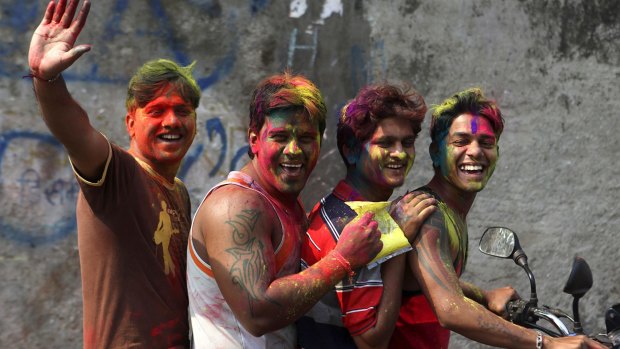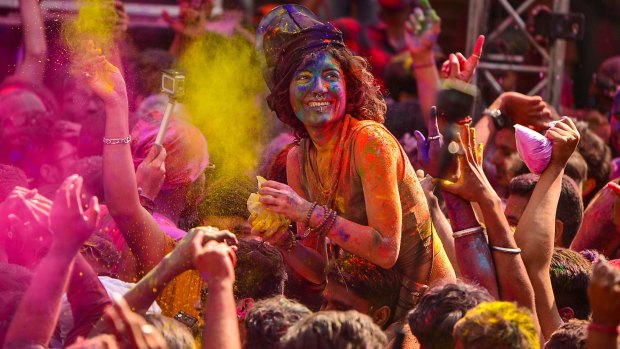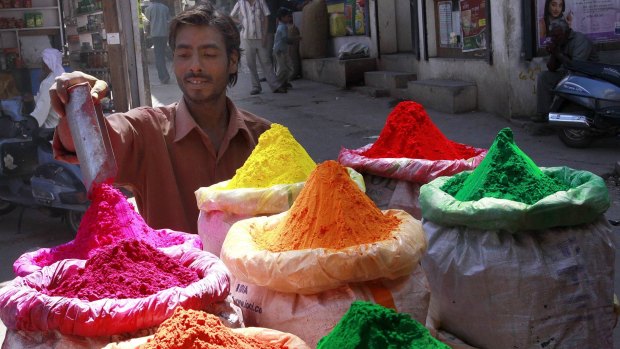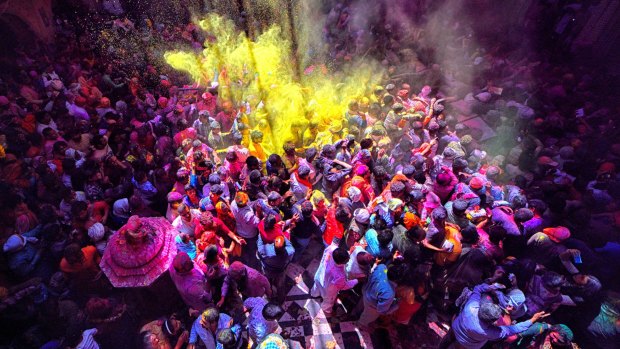By Max Anderson

Young men with their faces smeared with coloured powder as they ride a motorbike during Holi festivities in Mumbai.
It's colourful, fun and just a little bit mad. And, like it or not, you're invited …
Holi is a national holiday for most of India, one that sees hundreds of millions of people joyfully chucking colour and water over anything that moves – including foreign visitors. Whether you're half-way up a Himalayan mountain, in the far reaches of the Rajasthan deserts or in the busy streets of Delhi, you have no choice but to be part of it.
Though the ancient festival has Hindu origins, Holi is a surprisingly secular affair dedicated to having fun. It's timed to the lunar calendar and usually falls in mid-March. It also causes a blue-moon event which sees the nation's irrepressible merchants – as well as its public attractions – closed for the day.

A tourist celebrates Holi with Pushkar local people.Credit: Pacific Press
The festival is especially vibrant in the populous north (only moderately celebrated in the south) and with businesses shut for the holiday, you need to make sure you're settled into your pre-booked accommodation.
This is one party you want to be ready for.
DON'T MISS THE NIGHT BEFORE HOLI

A man prepares colourful powder for sale in the market ahead of the Holi festival in Bhopal.
The night before Holi is Holika dahan, which means "Holika death". It celebrates the death of a demon and offers some cultural insights, but rather like Christmas Eve it has a sense of feverish anticipation, and rather like Bonfire Night it's quite the spectacle.
If you're in a city or town, strike out at twilight and you'll find the streets, markets and cafes even more insane than usual. The vendors of gulal are especially frantic, selling bags of baby-soft powders in electric colours, scooped from great piles.
You'll also see multiple bonfires built in the chowks (squares), road junctions and narrow lanes. As the sun lowers, people gather to festoon the unlit pyres with garlands of flowers and strings of cow pats, and enact small pujas (prayers). The fires are lit after darkness falls, at which great throngs of people gather to circle the fires up to seven times. It's a dynamic, uplifting sight.

Hindu devotees seen throwing colourful powders (gulal) inside Bankey Bihari Temple of Vrindavan, India.
Though the burning relates to ancient Hindu scripts, you're actually witnessing a harvest festival of sorts, the end of winter and the celebration of spring and renewal – the very essence of Holi. When the pyres are reduced to ash, the farmers who work small plots of land (which is a lot of Indians) roast chickpeas over the coals, seeking blessings for the harvest to come.
And now the celebrations can begin …
MIX IT UP A LITTLE
Next morning you should prepare for one of the big surprises of Holi – and that's when your local hosts, who have hitherto afforded you only courteous pressed-palm greetings, open their arms and give you a hug.
Of course the person giving you a hug is already covered from head to foot in colourful powders and delighted at the opportunity to smudge and smear your clean clothes. It's perfectly disarming and sets the tone for the day.
The fun starts around 10am, and as a visitor you're likely to have three different options as to how you participate.
Since hospitality is a huge part of Holi, your hotel will almost certainly put on a lavish event, mixing foreign guests with friends and family, not to mention hordes of hyperactive kids armed with water guns and water-filled balloons. Expect live drummers, loud pop music and very early offers of rum, beer and whisky and possibly traditional bhang drinks made from marijuana. If backpackers are added to the mix, it becomes an almost Ibiza-type affair, with everyone ending up the colour of squished blueberries.
If you're in the care of local guides, you will likely be invited to join them on a more sedate though no less fun circuit of homes belonging to friends and family. At each house, a host will gently wipe colour onto your cheeks, forehead and hair (a gesture you will return). You'll then be entreated to consume drinks and traditional foods such as mathri (cumin biscuits), malpuas (pancakes) and gujiya (sweet dumplings).
If none of the above apply, you can simply take your chances on the streets, rendering yourself a very visible target to be alternatively enveloped in puffs of dust and deluged by watery assaults. Expect plenty of invitations to join in local fun.
The games traditionally stop sometime between lunch and early evening. All is quiet by dusk.
BE AWARE
Not to put a dampener on this happy affair, you should be mindful of a few grey areas.
Cheaper gulal can be quite harsh. If you're going to run the colourful gauntlet of the streets, there's no guarantee the colour is irritant-free or smooth as talc. Wear sunglasses to protect your eyes, and perhaps leave the white tuxedo at home because the cheaper dyestuff won't wash out.
In some streets it's not unusual to see blokes appearing more boisterous than usual. Holi is traditionally associated with equality of castes and a chance for men to indulge in alcohol and bhang. By 11am a few of them are looking worse for wear.
Groups like to travel from place to place, either on small fleets of motorbikes or by car. Drink-driving laws are not enforced like they are in Australia, and while there's a larger-than-normal police presence, the men in brown are more dedicated to mopping up if the party gets too messy rather than preventing drink-drive accidents.
EXPECT SOME COLOURFUL VARIATIONS
Although a national holiday, Holi is most vibrant in the populous north. The festival has also seen some transformations and adaptations over the centuries. Here are just five shades of Holi to be discovered across the country …
In Ahmedabad, Gujarat, it's traditional to suspend pots of buttermilk (handi) in the streets. Small boys form human pyramids to reach the pot, while girls try to slow them down by sloshing water over them. Any boy who breaks a pot earns the title of "Holi king".
The Spring Festival in Shantiniketan, West Bengal, was started by Nobel Laureate and poet Rabindranath Tagore. It features a huge cultural program of dance and song before the air fills with colour.
The Sikhs have happily embraced Holi and start throwing colour up to eight days before the day itself. Walls and courtyards of rural houses are decorated with artworks depicting flowers, ferns, creepers and peacocks.
Thousands gather in Radha Rani temple near Mathura in Uttar Pradesh for an unusual Holi ceremony in which women beat men with long sticks while onlookers become hysterical, singing and shouting. The men invite the beatings with provocative songs of their own, protecting themselves with round shields.
For a contemporary vibe, New Delhi's Holi Moo Festival has been going strong for 13 years. It's a hit with Delhi's hip young things and foreign travellers alike, and this year saw 100 artists performing eight hours of music with plenty of booze and bhang (dope lassis). When the colour-throwing starts, it gets psychedelic indeed.
FESTIVAL FACTS
1. Traditional Holi gulal is coloured with natural pigments. Orange and red for instance comes from the flowers of the striking palash tree (known as "flames of the forest"), powdered sandalwood, hibiscus flowers, radish and pomegranate.
2. Though of Hindu origin, Holi is celebrated by Sikhs, Jains and Buddhists. Some of the Muslim Mughals celebrated Holi, a time when people of low caste could throw colour on the emperor.
3. During Holika it's estimated some 30,000 bonfires go up in smoke every year, burning around 3000 tonnes of wood.
4. The festival of Holi has been recorded in fourth century texts.
5. European traders in the 17th century brought back word of the exuberant festival; researcher Karin Ebeling found variations in the Oxford English Dictionary including Houly (1687), Hooly (1698), Huli (1789), Hohlee (1809), Hoolee (1825), and Holi after 1910.
6. The Indian diaspora has ensured Holi is enjoyed across the world in countries like Fiji, South Africa, Mauritius and Suriname. Balinese Hindus also celebrate Holi.
TRIP NOTES
MORE
FLY
Singapore Airlines has daily flights to major Indian cities from Sydney, Melbourne and Brisbane, via Singapore. See singaporeair.com
TOUR
In 2020 Holi will fall on March 9-10.
Banyan Tours (banyantours.com/) can tailor an Indian itinerary to coincide with Holi, complete with guide and driver, activities and accommodation.
Max Anderson was a guest of Banyan Tours.
Sign up for the Traveller Deals newsletter
Get exclusive travel deals delivered straight to your inbox. Sign up now.